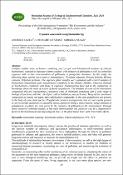Options
Exposure assessment using biomonitoring
ISSN
2668-8530
Date issued
2021-12
DOI
10.21698/rjeec.2021.211
Abstract
Complex studies were performed combining macroscopic and biochemical analyzes of selected biomonitors, exposed in exposure systems outdoor with mixtures of pollutants as well as controlled exposure with certain concentrations of pollutants in fumigation chambers. In this study, the following plant species were used as bioindicators: Nicotiana tabacum, Petunia hybrida, Ricinus Communis, Trifolium pretense. The exposure plant samples were compared with control samples of biomonitors maintained under standardized conditions in the climate chamber. Classical methods of biochemistry combined with those of exposure biomonitoring have led to the completion of knowledge about the ways of action of plants to pollution. The analysis of some of the antioxidant compounds that are representing a structural class of chemicals (enzymes) with a wide range of
biological functions, with the role of free radical inhibition, was performed. Many of the constituent
compounds in certain cell types, also called active compounds, in this case, polyphenols are present
in the body of some plant species. Polyphenols' presence in organisms, that are not usually present
or are in normal quantities, is caused by stress, (pollution being a stress factor). Large amounts of
polyphenols in plants are also given by the presence of pollutants in the environment. Through
these extensive combined studies, it has been demonstrated that pollution can be a degenerative
factor at the biochemical and physiological level, at the plant tissue level, with irreversible effects.
biological functions, with the role of free radical inhibition, was performed. Many of the constituent
compounds in certain cell types, also called active compounds, in this case, polyphenols are present
in the body of some plant species. Polyphenols' presence in organisms, that are not usually present
or are in normal quantities, is caused by stress, (pollution being a stress factor). Large amounts of
polyphenols in plants are also given by the presence of pollutants in the environment. Through
these extensive combined studies, it has been demonstrated that pollution can be a degenerative
factor at the biochemical and physiological level, at the plant tissue level, with irreversible effects.
Files
Loading...
Name
Articol 11 Proceedings.pdf
Size
491.96 KB
Format
Adobe PDF
Checksum
(MD5):e1aea8d6595c166817062668db023972